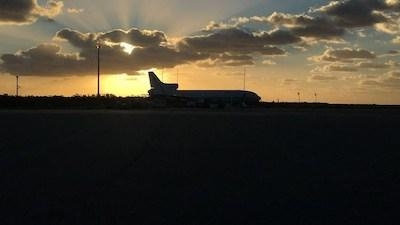Sat, Nov 10, 2018
Mission To Be 44Th Flight Of World's First Privately-Developed Commercial Rocket
Northrop Grumman Corporation is prepared to launch the company’s air-launched Pegasus XL rocket aboard its Stargazer L-1011 airplane from Cape Canaveral Air Force Station on November 7, at approximately 3:05 a.m. EST. This will be the 44th flight for Northrop Grumman’s unique air-launched Pegasus rocket.

Pegasus will be carrying NASA’s Ionospheric Connection Explorer (ICON) satellite, built by Northrop Grumman at its manufacturing facilities in Dulles, Virginia and Gilbert, Arizona. ICON will study the frontier of space – the dynamic zone high in Earth’s atmosphere where terrestrial weather from below meets space weather above. The explorer will help determine the physics of Earth’s space environment and pave the way for mitigating its effects on technology, communications systems and society. ICON is based on Northrop Grumman’s flight-proven LEOStar-2 spacecraft bus and adds to an extensive list of science satellites the company has developed and built for NASA over the last 35 years.
Northrop Grumman has previously provided both the satellite and launch vehicle for numerous NASA scientific missions. The most recent example of this dual capability occurred mid-2012 when the Northrop Grumman-built Nuclear Spectroscopic Telescope Array (NuSTAR) satellite launched on a Pegasus rocket. Other examples include the Interstellar Boundary Explorer (IBEX), the Aeronomy of Ice in the Mesosphere (AIM) satellite, the Solar Radiation and Climate Experiment (SORCE) and the Galaxy Evolution Explorer (GALEX).
Pegasus is the world’s first privately-developed commercial rocket and the leading launch system for deploying small satellites into low earth orbit. The rocket has a perfect launch record for more than 20 years.
A NASA Category 3 vehicle in the small-launch class, Pegasus is certified to launch NASA’s most valuable small satellites. NASA’s Launch Services Program, which matches spacecraft with launch vehicles, facilitated the launch.
The original air-launched space launcher, the Pegasus rocket launches from beneath Northrop Grumman’s Stargazer L-1011 carrier airplane, providing customers with unparalleled flexibility to operate from virtually anywhere on Earth with minimal ground support requirements. Previous Pegasus missions have launched from five separate sites in the U.S., Europe and the Marshall Islands.
(Image provided with Northrop Grumman Corporation news release)
More News
“We respectfully call on the City of Mesa to: 1. Withdraw the landing fee proposal immediately 2. Engage with the aviation community before making decisions that impact safet>[...]
High Speed Taxiway A long radius taxiway designed and provided with lighting or marking to define the path of aircraft, traveling at high speed (up to 60 knots), from the runway ce>[...]
Aero Linx: International Federation of Airworthiness (IFA) IFA uniquely combines together all those with responsibility for policies, principles and practices concerned with the co>[...]
Controller’s Expectation That VW02 Would Have Departed Sooner Led To An Inadequate Scan And Loss Of Situational Awareness Analysis: A Robinson R-44 helicopter N744AF, VW02 (V>[...]
A Few Questions AND Answers To Help You Get MORE Out of ANN! 1) I forgot my password. How do I find it? 1) Easy... click here and give us your e-mail address--we'll send it to you >[...]
 Aero-News: Quote of the Day (12.09.25)
Aero-News: Quote of the Day (12.09.25) ANN's Daily Aero-Term (12.09.25): High Speed Taxiway
ANN's Daily Aero-Term (12.09.25): High Speed Taxiway ANN's Daily Aero-Linx (12.09.25)
ANN's Daily Aero-Linx (12.09.25) NTSB Final Report: Diamond Aircraft Ind Inc DA20C1 (A1); Robinson Helicopter R44
NTSB Final Report: Diamond Aircraft Ind Inc DA20C1 (A1); Robinson Helicopter R44 ANN FAQ: Q&A 101
ANN FAQ: Q&A 101



